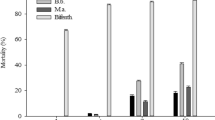Abstract
Attention is drawn to the limitations of conventional methods of controlling important trematode infections such as schistosomosis and fasciolosis. Plant molluscicides could have a role in the future control of these infections. There are, however, major problems with most plant molluscicides in that their use is labour-intensive, in many cases relatively skilled workers are required, they must be applied regularly and arable land may be required for their cultivation. Thus, little progress is to be expected until plant species with sustainable self-delivery systems are identified.Eucalyptus is proposed as a likely candidate. The leaves of many species in this genus have molluscicidal properties and their intermittent fall could effect self-delivery if the trees were planted in appropriate places. Relatively little work has been carried out on this possibility and much more is necessary, especially field trials. Before field trials are started, more laboratory testing is also necessary to determine the LC50 values for different snail species and to study toxicity to non-target organisms.
Similar content being viewed by others
References
Bali, H.S., Singh Sawai and Pati, S.C., 1985. Preliminary screening of some plants for molluscicidal activity against two snail species.Indian Journal of Animal Sciences,55, 338–340
Broberg, G., 1982. Molluscicidal effects of eucalyptus.Veterinary Record,110, 586
Cheng, T.H., 1971. Schistosomiasis in mainland China: a review of research and control programmes since 1949.American Journal of Tropical Medicine and Hygiene,20, 26–53
Cheruiyot, H.K. and Wamae, L.W., 1988. Effect of grinding ofEucalyptus globosus leaves on the molluscicidal properties.Bulletin of Animal Health and Production in Africa,36, 281–282
Cheruiyot, H.K., Broberg, G., Wamae, L.W. and Wachira, T.M., 1981. Effect of eucalyptus leaves on the survival of aquatic snails.East African Agricultural and Forestry Journal,46, 77–80
Cowper, S.G., 1948. The effect of certain inorganic and vegetable substances on the English pond snailPlanorbis corneus (Linné, 1758).Annals of Tropical Medicine and Parasitology,42, 119–130
Coyle, T.J., 1961.The epidemiology of Fasciola giganticain cattle of Uganda Protectorate (Thesis, Royal College of Veterinary Surgeons, London)
Farnsworth, N.R., Henderson, T.O. and Soejarto, D.D., 1987. In: K.E. Mott (ed.),Plant Molluscicides, (Geneva, UNDP/World Bank/WHO Special Programme for Research and Training in Tropical Diseases, 1983), 178
Gardner, C.A. and Bennetts, H.W., 1956.The Toxic Plants of Western Australia, (Perth, West Australian Newspapers Periodicals Division)
Hammond, J.A., 1970.Studies on fascioliasis with special reference to Fasciola giganticain East Africa, (Thesis, University of Edinburgh)
Jagannath, M.S., D'Souza, P.E., Rahma, S.A. and Abdul-Rahman, S., 1986. A preliminary study on the effect ofEucalyptus tereticornis leaves on snails.Mysore Journal of Agricultural Sciences,20, 131–132
Kellerman, T.S., Coetzer, J.A.W. and Naudé, T.W., 1988.Plant Poisonings and Mycotoxicoses of Livestock in Southern Africa, (Cape Town, Oxford University Press)
Kloos, H. and McCullough, F.S., 1982. Moluscicidal effects of eucalyptus.Veterinary Record,111, 148
Kloos, H. and McCullough, F.S., 1987. In: K.E. Mott (ed.),Plant Molluscicides, (Geneva, UNDP/World Bank/WHO Special Programme for Research and Training in Tropical Diseases, 1983), 45–108
Kloos, H., Thiongo, F.W., Ouma, J.H. and Butterworth, A.E., 1987. Preliminary evaluation of some wild and cultivated plants for snail control in Machakos District, Kenya.Journal of Tropical Medicine and Hygiene,90, 197–204
McCullough, F.S., Gayral, P.H., Duncan, J. and Christie, J.D., 1980. Molluscicides in schistosomiasis research.Bulletin of the World Health Organization,58, 681–689
Mendes, N.M., Araujo, N., de Souza, C.P., Pereira, J.P. and Katz, N., 1990. Atividade molluscicida e cercaricida de differentes espécies de eucalyptus.Revista da Sociedade Brasiliera de Medicina Tropical,23, 197–199
Mozley, A., 1944.The Control of Bilhariza in Southern Rhodesia, (Salisbury, Rhodesian Printing and Publishing Co.)
Pryor, L.D., 1976.Biology of Eucalypts, (London, The Institute of Biology)
Rouquayrol, M.Z., Fonteles, M.C., Alencar, J.E., Matos, F.J.A. and Craveiro, A.A., 1980. Atividade molluscicida de óleos essenciais de plantas do nordeste Brasileiro.Revista Brasileira de Pesquisas Medicas e Biologicas,13, 135–143
Verdcourt, B. and Trump, E.C., 1969.Common Poisonous Plants of East Africa, (London, Collins)
Webber, J.J., Roycroft, C.R. and Callinan, J.D., 1985. Cyanide poisoning of goats from sugar gums (Eucalyptus cladocalyx).Australian Veterinary Journal,62, 28
WHO, 1965. Molluscicide screening and evaluation.Bulletin of the World Health Organisation,33, 567–581
Wickens, G.E., 1987. In: K.E. Mott (ed.),Plant Molluscicides, (Geneva, UNDP/World Bank/WHO Special Programme for Research and Training in Tropical Diseases, 1983), 223
Author information
Authors and Affiliations
Rights and permissions
About this article
Cite this article
Hammond, J.A., Fielding, D. & Nuru, H. Eucalyptus: A sustainable self-delivery molluscicide?. Vet Res Commun 18, 359–365 (1994). https://doi.org/10.1007/BF01839286
Accepted:
Issue Date:
DOI: https://doi.org/10.1007/BF01839286




